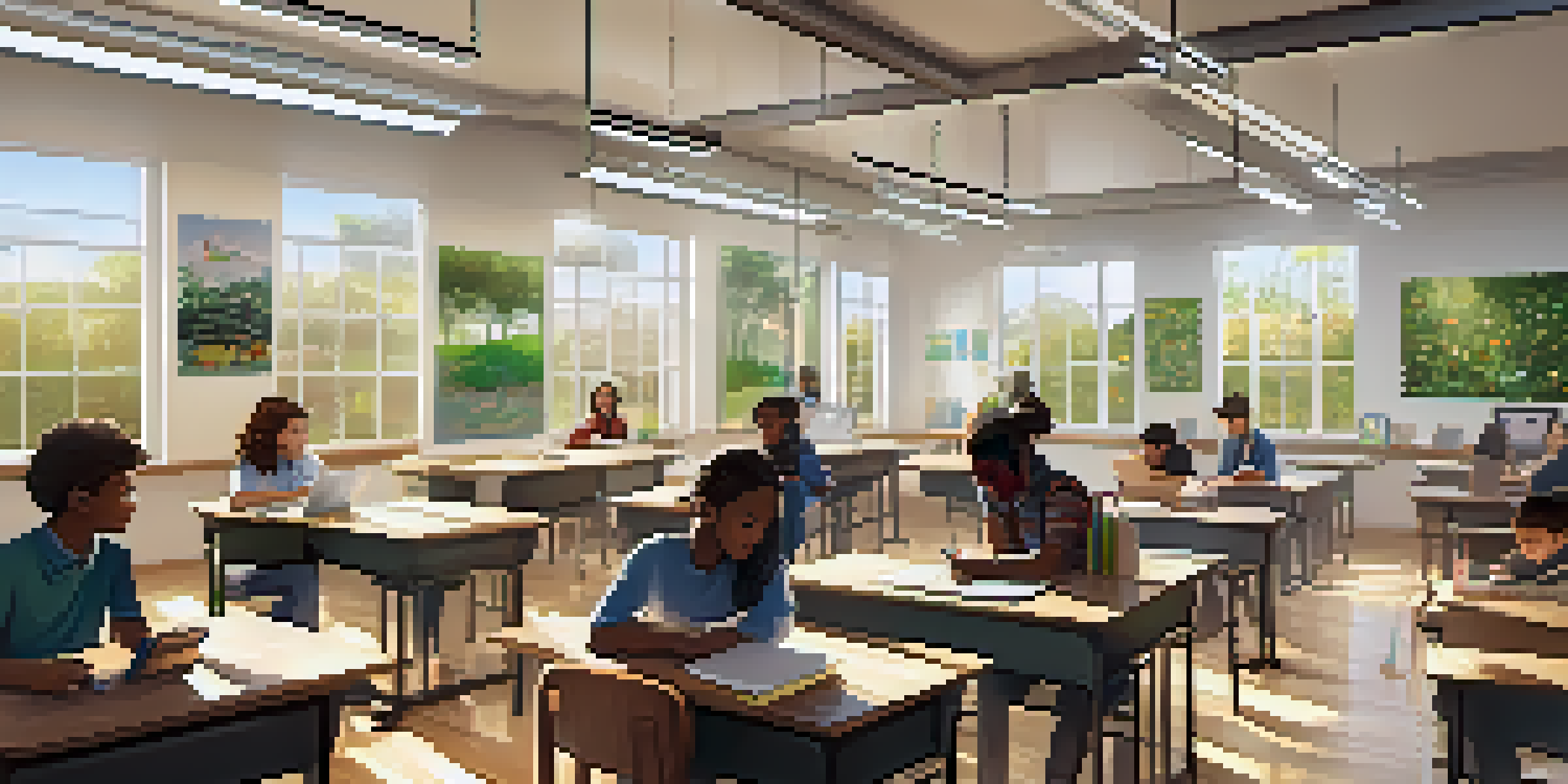The Importance of Well-Being in Blended Learning Environments

Understanding Blended Learning and Well-Being
Blended learning combines traditional face-to-face education with online learning. This approach allows for flexibility and personalization, catering to diverse learning styles. However, the focus on technology can sometimes overshadow the emotional and mental well-being of students.
The ability to learn faster than your competitors may be the only sustainable competitive advantage.
Well-being in this context refers to the overall health of students, including their mental, emotional, and social aspects. When learners feel supported and valued, they are more likely to engage actively in their education. Thus, integrating well-being practices into blended learning is essential for optimal outcomes.
A positive learning environment fosters motivation and resilience, enabling students to navigate challenges effectively. By prioritizing well-being, educators can create a space where students thrive both academically and personally.
The Link Between Well-Being and Academic Performance
Research consistently shows that students with high well-being tend to perform better academically. When learners feel mentally and emotionally secure, they are more focused and engaged, leading to improved retention of information. This connection underscores the need to prioritize well-being in blended learning environments.

For example, consider a student struggling with anxiety. If their emotional needs are addressed through supportive online resources or in-person check-ins, they may find it easier to participate in discussions and complete assignments. This illustrates how addressing well-being can directly impact academic success.
Blend Learning Boosts Well-Being
Integrating well-being practices into blended learning environments enhances students' emotional and mental health, leading to better academic outcomes.
Therefore, fostering a culture that values mental health not only benefits students individually but enhances the overall learning atmosphere. It creates a ripple effect where improved well-being leads to higher achievements for everyone.
Creating Supportive Online and Offline Spaces
In blended learning, it's crucial to create supportive spaces both online and offline. Online platforms should encourage interaction and collaboration, allowing students to connect with peers and instructors. Features like discussion boards and group projects can enhance this sense of community.
Well-being is not just the absence of stress; it's the presence of support and connection.
On the other hand, face-to-face interactions should prioritize emotional support, providing opportunities for students to share experiences and challenges. Regular check-ins or counseling sessions can help identify students who may be struggling, ensuring they receive the necessary support.
By blending these supportive elements, educators can cultivate an environment where students feel safe and valued. This not only promotes well-being but also enhances overall learning effectiveness.
Incorporating Mindfulness Practices in Learning
Mindfulness practices, such as meditation or breathing exercises, can be beneficial in blended learning environments. These techniques help students manage stress and improve focus, which is crucial in a setting that often shifts between online and in-person formats. Incorporating short mindfulness sessions into the daily routine can set a positive tone for learning.
For instance, starting a virtual class with a few minutes of guided meditation can help students transition from their personal lives to a learning mindset. This simple practice can enhance their ability to engage with the material and participate actively.
Social Connections Enhance Learning
Fostering social interactions among students in blended learning helps build a supportive community, which is crucial for both well-being and academic success.
As students become more aware of their thoughts and feelings, they develop better self-regulation skills. This not only supports their academic pursuits but also contributes to their overall well-being.
Encouraging Social Connections Among Students
Social connections are vital for well-being, especially in blended learning environments where isolation can occur. Encouraging students to collaborate and communicate fosters a sense of belonging and community. This can be achieved through group projects, peer mentoring, or social events, whether online or in-person.
For example, creating virtual study groups or hosting online game nights can help students bond over shared interests. These interactions can alleviate feelings of loneliness and promote a supportive network among peers.
Strong social connections not only enhance well-being but also lead to improved academic outcomes. When students feel connected, they are more likely to seek help and support from one another, creating a collaborative learning environment.
The Role of Educators in Promoting Well-Being
Educators play a pivotal role in fostering well-being in blended learning environments. By being approachable and responsive, they can create a safe space for students to express their concerns. Training educators to recognize signs of distress and intervene appropriately is essential for maintaining a supportive atmosphere.
Additionally, incorporating well-being topics into the curriculum can help raise awareness among students. Discussions around mental health, stress management, and resilience can empower learners to prioritize their well-being actively.
Educators Shape Supportive Spaces
Educators play a vital role in promoting well-being by creating approachable environments and incorporating mental health discussions into the curriculum.
When educators model healthy behaviors and promote well-being initiatives, they set a powerful example for students. This creates a culture where well-being is valued, ultimately benefiting everyone in the learning community.
Measuring Well-Being in Blended Learning
To effectively promote well-being, it’s important to measure it regularly. Surveys and feedback tools can help educators assess students' emotional and mental health, providing valuable insights into their experiences. This data can guide decisions about support services and resources needed in the learning environment.
For instance, implementing regular check-ins or pulse surveys can help gauge student sentiment. If many students express feelings of stress or disconnection, educators can take proactive steps to address these issues.

By actively measuring well-being, institutions can adapt their approaches and ensure that students feel supported throughout their blended learning journey. This ongoing evaluation ensures that well-being remains a priority in educational settings.